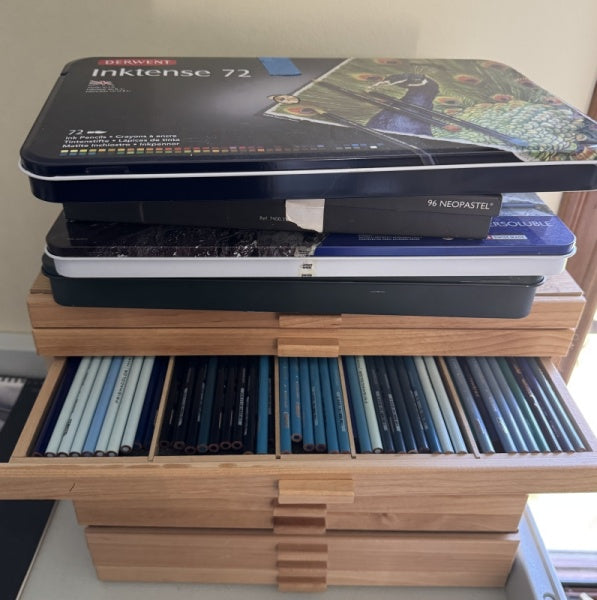Seeing in 2 Dimensions, Creating art with Stereo-blindness
by Paula Williams
I am an artist. An artist with a disability that could have stopped me in my tracks and kept me from doing what came naturally to me. The urge to draw and create has always been part of my life but I was born 80 % blind in my right eye. A condition that affected all aspects of my life—always. This condition was diagnosed when I was two years old only to find out there was virtually nothing that could be done. However, my parents found a physician that was willing to try an experiment as there were no tried and true solutions. He placed an eye patch over the good eye in hopes that it would strengthen the poorer one. They placed a pair of glasses over my eyes which was to help work the bad eye. The patch was worn for about 3 years and slowly improved with time but was far from perfect. I always knew that I only saw out of my left eye.

A Love as True as Mine
Someone recently asked me how old I was when I knew I would be an artist. It gave me pause as I never really thought about it before; this was an inherent part of my identity. As early as Nursery school, the colors in the juice cans at the easel fascinated me. So much so that I had poor socialization skills, my teachers kept dragging me away from the paints. Encouragement came easily when I was younger but changed when I entered college.
It was mandatory to explore all mediums from wet to dry, pottery, and woodworking. I was a mess with any kind of wet material, like paint, but excelled working with dryer tools. Choosing colored pencils was an easy choice, as I loved the spectrum of colors. Blending to create new shades thrilled me. Sharpening them allowed for more detail in my work. Creating new pieces brought me so much joy.

The Best Boy
My professors, though, advised my work was skewed. Assuredly, my drawing skills were decent enough, but my uncertainty grew when my educators slowly gave up on working with me on my creative process. I couldn’t determine the contrast between what everyone else saw and what I saw. I struggled to make sense of the projects the class needed to complete. Often, my work was noted as different in an uncomplimentary way.
As a result, I dreaded critique day. Overall, I was accepted by my schoolmates, but I often felt humiliated as my work was subject to heavy criticism. A common theme was my attention to detail, I was told it was too much and unnecessary. It was explained to me that I needed to place as much information for the viewer to understand my message, but my professors didn’t understand this is how I saw my world. This didn’t deter me, however. Art is another part of how I saw my world, and nothing would get in between this artistic journey I was set upon.

Time Marches On
It was only after I graduated from college that my skills were continuously refined and through my determination, I noted that my drawings started to straighten out. I still could not figure out the reason why I had so much trouble in school. I spoke with my optometrist, and she informed me only recently that because of my eye condition I do not see the world around me in three dimensions but in two. This condition is known as stereo-blindness (a condition that Rembrandt also had as it is documented). Visual acuity is truly accomplished with binocular vision. This meant both eyes must work in tandem with each other, but my eyes lack this ability so I cannot see the same way as other artists do. With depth perception, the perceived distance is between the background and foreground. Understanding basic drawing and the perspective lesson was the most important I could learn. I work around this challenge by creating an illusion of depth with two dimensions that require much consideration, which ultimately helps supplement what I am not seeing.
I surmise this is why my work is so very detailed, to make up for the dimension that is lacking. The lessons learned during my education have helped in creating some of my most celebrated pieces to date. Because of my unique situation, I have a further appreciation of my progress and my artistic journey forward.
ABOUT PAULA WILLIAMS:

Paula creates works of art that explores the beauty of everyday life through the vibrant language of colored pencils, always challenging her growing skills. She attended Rochester Institute of Technology’s School of Art and Design and earned her Bachelor of Arts Degree. She has taught adults in basic drawing and colored pencil classes that she developed. She has been featured in Ann Kullberg’s Color Magazine and several issues of Colored Pencil Hidden Treasures. She is a member of CPSA.
Facebook: Pencil To Paper Renderings
I am an artist. An artist with a disability that could have stopped me in my tracks and kept me from doing what came naturally to me. The urge to draw and create has always been part of my life but I was born 80 % blind in my right eye. A condition that affected all aspects of my life—always. This condition was diagnosed when I was two years old only to find out there was virtually nothing that could be done. However, my parents found a physician that was willing to try an experiment as there were no tried and true solutions. He placed an eye patch over the good eye in hopes that it would strengthen the poorer one. They placed a pair of glasses over my eyes which was to help work the bad eye. The patch was worn for about 3 years and slowly improved with time but was far from perfect. I always knew that I only saw out of my left eye.

A Love as True as Mine
Someone recently asked me how old I was when I knew I would be an artist. It gave me pause as I never really thought about it before; this was an inherent part of my identity. As early as Nursery school, the colors in the juice cans at the easel fascinated me. So much so that I had poor socialization skills, my teachers kept dragging me away from the paints. Encouragement came easily when I was younger but changed when I entered college.
“My work was noted as different
in an uncomplimentary way.”
It was mandatory to explore all mediums from wet to dry, pottery, and woodworking. I was a mess with any kind of wet material, like paint, but excelled working with dryer tools. Choosing colored pencils was an easy choice, as I loved the spectrum of colors. Blending to create new shades thrilled me. Sharpening them allowed for more detail in my work. Creating new pieces brought me so much joy.

The Best Boy
My professors, though, advised my work was skewed. Assuredly, my drawing skills were decent enough, but my uncertainty grew when my educators slowly gave up on working with me on my creative process. I couldn’t determine the contrast between what everyone else saw and what I saw. I struggled to make sense of the projects the class needed to complete. Often, my work was noted as different in an uncomplimentary way.
“I do not see the world around me
in three dimensions but in two.”
As a result, I dreaded critique day. Overall, I was accepted by my schoolmates, but I often felt humiliated as my work was subject to heavy criticism. A common theme was my attention to detail, I was told it was too much and unnecessary. It was explained to me that I needed to place as much information for the viewer to understand my message, but my professors didn’t understand this is how I saw my world. This didn’t deter me, however. Art is another part of how I saw my world, and nothing would get in between this artistic journey I was set upon.

Time Marches On
It was only after I graduated from college that my skills were continuously refined and through my determination, I noted that my drawings started to straighten out. I still could not figure out the reason why I had so much trouble in school. I spoke with my optometrist, and she informed me only recently that because of my eye condition I do not see the world around me in three dimensions but in two. This condition is known as stereo-blindness (a condition that Rembrandt also had as it is documented). Visual acuity is truly accomplished with binocular vision. This meant both eyes must work in tandem with each other, but my eyes lack this ability so I cannot see the same way as other artists do. With depth perception, the perceived distance is between the background and foreground. Understanding basic drawing and the perspective lesson was the most important I could learn. I work around this challenge by creating an illusion of depth with two dimensions that require much consideration, which ultimately helps supplement what I am not seeing.
I surmise this is why my work is so very detailed, to make up for the dimension that is lacking. The lessons learned during my education have helped in creating some of my most celebrated pieces to date. Because of my unique situation, I have a further appreciation of my progress and my artistic journey forward.
ABOUT PAULA WILLIAMS:

Paula creates works of art that explores the beauty of everyday life through the vibrant language of colored pencils, always challenging her growing skills. She attended Rochester Institute of Technology’s School of Art and Design and earned her Bachelor of Arts Degree. She has taught adults in basic drawing and colored pencil classes that she developed. She has been featured in Ann Kullberg’s Color Magazine and several issues of Colored Pencil Hidden Treasures. She is a member of CPSA.
Facebook: Pencil To Paper Renderings




